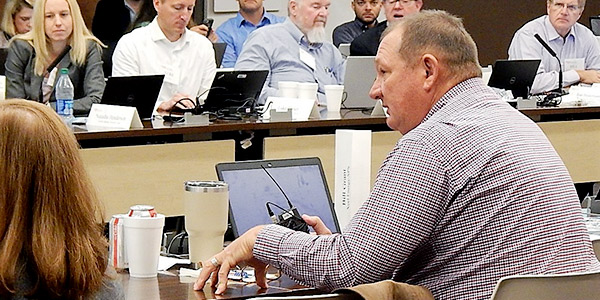By Tom Kleckner
LITTLE ROCK, Ark. — SPP stakeholders last week debated a future that could be very different from the one they are currently planning for, but cost concerns and uncertainty prevented them from changing course — just yet.
The Markets and Operations Policy Committee and the Strategic Planning Committee devoted several hours of meeting time to discussing the 2021 Integrated Transmission Planning (ITP) process’ 10-year assessment and whether it should include a scenario depicting steep reductions in carbon emissions.
The “carbon-reduction” future is one of three futures the Economic Studies Working Group (ESWG) has proposed for the 2021 ITP. The scenario is “driven primarily by the assumption of new environmental regulations” arising out of the political environment and assumes the reinstatement of renewable tax credits and accelerated retirements of fossil-fuel generation. It also assumes as much as 55 GW of wind and solar energy in 2031 and fossil retirements based on capacity factors for those resources.
“You just retired my entire fleet,” Southwestern Public Service’s Bill Grant told ESWG Chair Alan Myers during MOPC’s Oct. 15 discussion, referring to SPS’ gas units.
Never one to hold back expressing his thoughts, former SPP Chairman Jim Eckelberger put it bluntly.
“In January 2021, the White House will be filled with a nut who doesn’t think global warming exists,” he said, “or the White House will be filled with a nut who believes everything should be green.”
“The big driver that transcends either of those nutty scenarios is that industry economics and industrial leaders are driving this train now,” said SPP’s current chairman, Larry Altenbaumer. “Whoever is in the White House is completely separate.”
“Solar with batteries is going to become the modus operandi of how it’ll be implemented on a utility basis,” Eckelberger said.
MOPC and the SPC both endorsed eliminating the carbon-reduction future. Eckelberger and fellow director emeritus Harry Skilton were the only SPC members in favor of keeping the scenario, envisioning a future with more solar and storage than currently projected.
“When do you want to be in a position where you do long-term thinking?” Eckelberger asked. “You may be on the wrong side of the pattern if you do it too soon. Let’s make sure we’re in a position where we’re building something that looks to us very different than where we are now.”
“We’re going to be increasingly in a carbon-constrained world,” said Basin Electric Power Cooperative’s Tom Christensen. “Even if there’s a change in administration, isn’t it better if we have a cost for transmission and the buildout in a carbon-constrained world? I would advocate for at least something that’s very aggressive on the level of renewables that we model and understand what transmission would need to get built. We should have an answer. If you don’t have an answer, somebody else will have an answer.”
The ESWG’s other two proposed futures include a reference case (previously referred to as the “business-as-usual” case) that includes additional renewable and energy storage resources and an “emerging technologies” case that assumes distributed generation, demand response, energy efficiency and storage will affect load and energy growth rates.
‘Already Way Behind’
MOPC rejected the carbon-reduction future over cost concerns, in large part because SPP said the incremental manpower needed to study the third future would require 7,000 hours over a two-year period.
SPP’s Market Monitoring Unit recommended the carbon-reduction case be studied as the second future, saying it takes into account corporate policy changes in the footprint, such as increased renewables buildout and higher carbon-reduction targets.
“I think it’s short-sighted to not be thinking we need to plan for the future. It’s not going to be driven by Washington or the regulators. It’s going to be driven by the consumers,” said Evergy’s Denise Buffington. “Consumers are saying they want green energy. Where do you find green energy? In remote areas.
“In order to meet the demands of our consumers, we have to figure out transmission planning and cost allocation. It’s extremely short-sighted to say it’s not coming. It is. It’s here, and we’re already way behind,” she said.
“Using just two futures is really not sufficient to test the ability of the transmission design coming out of the ITP to handle the plausible uncertainty that exists on a ten-year horizon,” the Advanced Power Alliance’s Steve Gaw told RTO Insider. “Today we have substantial changes underway in SPP. The premise is the two scenarios that are being used are the only two that are plausible over the next two years. I do not think that is a smart assumption.”
Staff said the third future was not intended to create a portfolio of projects but rather to inform the portfolio that could result from the first two futures. However, SPP took on an action item to evaluate whether it can accelerate the 2022 ITP 20-year assessment by completing it in 2021 in parallel with the 10-year assessment.
By taking a longer look into the future, “you can right-size your project,” said SPP Senior Vice President of Engineering Lanny Nickell.
Oklahoma Gas & Electric’s Greg McAuley said what has worked in the past for transmission owners won’t necessarily work today.
“To put that kind of certainty out there as something we’re planning for doesn’t make sense to us,” he said. “We cannot forget that the entities around this table who represent load are in a ‘what-have-you-done-for-me lately’ world. That’s where we operate every day.
“This organization has done the best thing for its region that can be done,” McAuley said, referring to SPP’s more than $10 billion in transmission investments over the past 10 years. “We have some of the lowest rates in the country because of what this organization has done. The question before us is, ‘What have you done for me lately?’”








